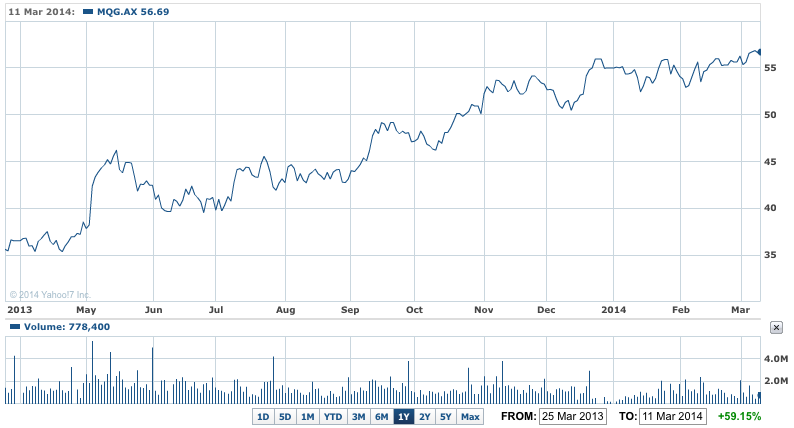Macquarie Group (MQG) will have a better final quarter than many of its larger peers on Wall Street and in Europe and Japan, judging by the Australian bank’s near end of financial year trading update yesterday.
Macquarie, which rules off its year next Monday, March 31 (and its final quarter and second half) significantly bolstered expectations for its 2013-14 earnings, saying profit could rise by up to 45%, subject to the completion of a number of pending transactions.
The company said in yesterday’s update that earnings in its Fixed Income Currencies and Commodities (FICC) unit had improved, which would see a result in that division in line with or slightly better than 2013. Previously, Macquarie had expected a much weaker result from the FICC unit.
That’s where Macquarie departs from its larger peers, such as Citi and JPMorgan, who have warned of double digit revenue falls in this area (which is the core operation for these big banks, involving trading bonds, other securities, currencies and commodities).
In fact one survey earlier this month suggested that the big banks on Wall Street and Europe were looking for falls of up to 25% in trading revenues. (The FICC are the trading and reveue engines of investment banks.)
US analysts reckon most big banks will struggle to replace these revenue losses from elsewhere in operations.
While they all have significant funds management businesses, even those have been hit by the move away from commission-generating revenue to flat fees as more and more investors demand index tracking, low cost (fee based) funds, such as those modelled on the highly successful and very large Vanguard funds.
Macquarie has more than $A400 billion under management, but much of that is actively managed.
MQG 1Y – Macquarie’s prospects improve

Macquarie said yesterday it now expects full-year earnings would come in about 40% to 45% higher than in 2012-13.
That suggests the company is on track for an annual profit of as much as $A1.23 billion.
If achieved, that will be better than the bank’s February earnings guidance which suggested the company would beat last year’s $851 million annual profit. The bank earned $501 million in the first half of this year.
Just on the broadbrush update yesterday, it´s clear Macquarie won’t beat the 2008 record profit of $1.8 billion.
But it’s going to be well clear of the $871 million profit it posted in 2008-09 when the GFC whacked the bank sideways (and 2013’s $851 million).
It could be the third highest so far, after 2008’s record $1.8 billion profit and the $1.46 billion profit in 2006-2007. A real case of back to the future.
Macquarie shares were sold off after February’s update which the market saw as disappointing because Macquarie stuck to its conservative outlook and pointed to the $1 billion profit, when the market wanted more.
Yesterday it seems the bank gave the market that wish and the shares were up 2.5% at $56.35, easing during the day as the local market sold off on news of weak data from China.
Macquarie chief financial offer Patrick Upfold will outline the company’s revised expectations at a Credit Suisse investment conference in Hong Kong later this week. That’s where Reserve Bank Governor Glenn Stevens is due to speak.
To justify the current share price (and a rise to the all time high level of $57.80), Macquarie will have to produce a strong upgrade of 2014-15 earnings when it reports in May, otherwise investors will again fret.
But watch what the big US banks say in their first quarter updates in around three weeks time. That will tell us a lot about the outlook for investment banking.
The detailed presentation shows that Macquarie’s funds management business (an extra $A48 billion under management since last September to $A433 billion) will produce more income because of the expanded base, higher fees and the favourable impact of the lower Aussie dollar against the US currency (much of the bank’s funds under management are in the US).
The Australian dollar hit 91.37 US cents overnight, meaning the impact of the lower currency on Macquarie is being slowly eroded (compared with the currency under 90 US cents).













